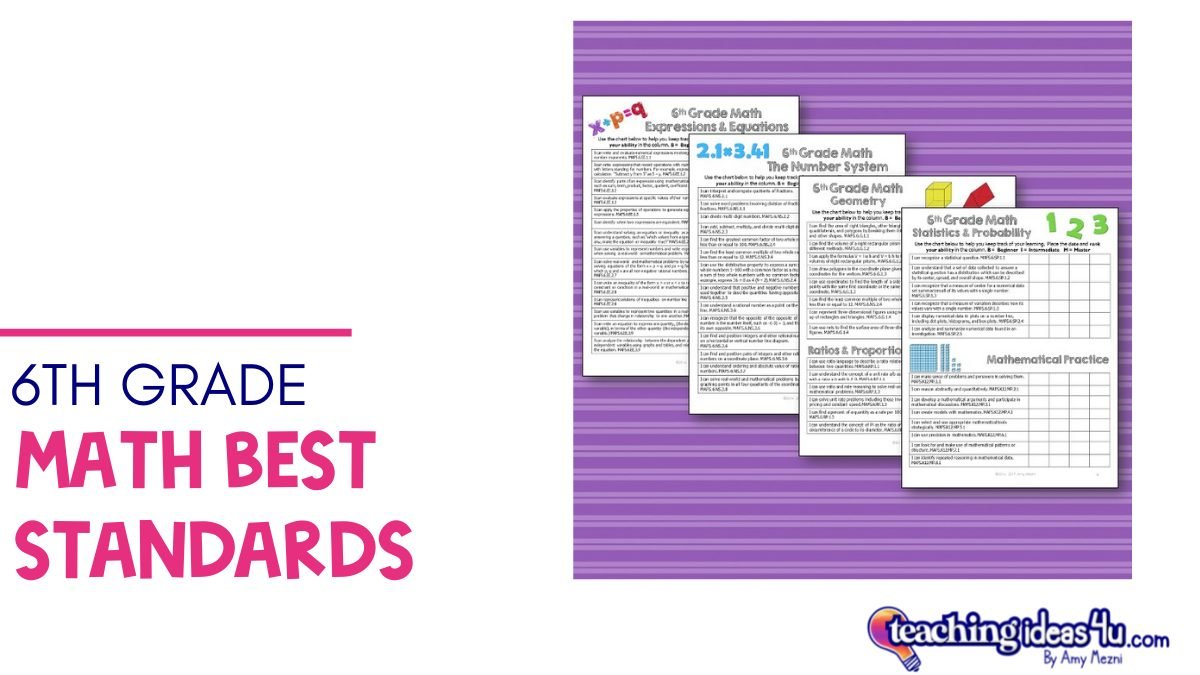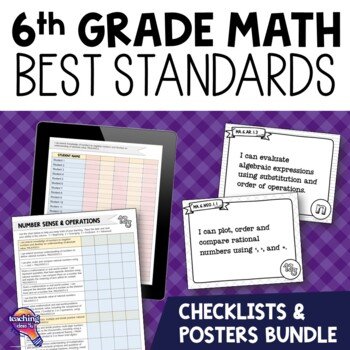6th Grade Math BEST Standards
What can sixth-grade teachers expect from the new Florida BEST Standards for math? How do they compare to the MAFS standards? What are sixth-grade students now expected to learn?
Set your mind at ease, because I am going to break down the new sixth-grade Math BEST standards. In this post, I will quickly analyze the changes and how they will affect your classroom.
How are the BEST Standards organized?
In sixth grade, Math BEST standards are divided into 5 subcategories:
Number Sense and Operations - Previously, these standards were mostly in The Number System, but some were in Expressions & Equations.
Data Analysis and Probability – These standards had been called Statistics and Probability.
Algebraic Reasoning – The standards in this section line up to the ones in Expressions & Equations and Ratios & Proportional Relationships.
Geometric Reasoning – Previously Geometry, but some standards had been in The Number System.
Mathematical Thinking and Reasoning – This was Mathematical Practice. These are the global standards students are expected to use throughout their school career.
The Changes
Honestly, there are not many major changes to the math standards. A lot of the updates feel like changes in wording more than an actual change in concepts taught. Sixth grade does add a few new skills, and a few others are slightly altered.
For ease of organization, I am going to discuss the new standards by subcategory.
Mathematical Thinking & Reasoning
These standards are the overarching skills students are meant to improve throughout their math classes.
The word precision was changed to fluency (MA.K12.MTR.3.1 - Complete tasks with mathematical fluency.)
The big changes are in what was removed:
“Create models with mathematics.”
“Select and use appropriate mathematical tools strategically.”
More discussion on these two things later. These two standards seem to tie into many of the standards that either had their wording changed or were omitted in BEST.
Number Sense and Operations
There weren’t really changes in concepts in this section. Primarily, the same concepts are covered, although standards have slightly changed. The only big omission I saw was that dependent and independent variables were not mentioned in the standards.
Other than that, the things to note are:
6.NSO.1.1 – Plot, order, and compare rational numbers using <, >, and =.
6.NSO.1.4 – Solve mathematical and real-world problems involving absolute value, including the comparison of absolute value.
6.NSO.3.4 – Express composite whole numbers as a product of prime factors with natural number exponents.
6.NSO.1.4 – Rewrite positive rational numbers in different but equivalent forms, including fractions, terminating decimals, and percentages.
Algebraic Reasoning
The only big change I saw was pi was removed. Otherwise, there are no surprises in this section.
Again, just a few standards to note:
6.AR.2.1 – Given an equation or inequality and a specified set of integer values, determine which values make the equation or inequality true or false.
6.AR.2.4 – Determine the unknown decimal or fraction in an equation involving any of the four operations, relating three numbers, with the unknown in any position.
6.AR.3.2 – Given a real-world context, determine a rate for a ratio of quantities with different rates. Calculate and interpret the corresponding unit rate.
6.AR.3.3 – Extend previous understandings of fractions and numerical patterns to generate or complete a two- or three-column table to display equivalent part-to-part ratios and part-to-part-to-whole ratios.
Data Analysis and Probability
Although these standards cover most of the same concepts, what students are expected to do appears to be more difficult. For example, MAFS said students need to “recognize” concepts, whereas BEST says they will “determine” and “describe.” The standards are more specific in what students should achieve.
Also, dot plots were not mentioned in the new standards.
New standards to consider:
6.DP.1.3 – Given a box plot within a real-world context, determine the minimum, the lower quartile, the median, the upper quartile, and the maximum. Use this summary of the data to describe the spread and distribution of the data.
6.DP.1.4 – Given a histogram or line plot within a real-world context, qualitatively describe and interpret the spread and distribution of the data, including any symmetry, skewness, gaps, clusters, outliers, and the range.
Geometry
Geometry still focuses on the coordinate plane and two- and three-dimensional figures. A few standards to note, as they seem to be a change in expectations:
6.GR.1.1 – Identify the x- or y-axis as the line of reflection when two ordered pairs have an opposite x- or y-coordinate.
6.GR.2.2 – Derive a formula for the area of a right triangle using a rectangle.
6.GR.2.2 – Apply a formula to find the area of a triangle. Students are to know the formula by memory.
Takeaways
Overall, the standards did not change very much. Pi was removed, but the core concepts seemed to stay the same beyond that.
In many cases, it seems like students are learning the same concepts, but what they are being asked to learn is slightly different (or at least the verbiage is different.)
One of my critiques is that the BEST standards removed some of the specific building blocks in lower grades that help students understand the thinking and learn the vocabulary they will need in future grades, such as understanding the distributive property and understanding fraction comparisons need to be on the same whole.
The Benchmark Clarifications are one of my big critiques of the BEST standards. While I appreciate having the standards clarified, there are so many of these clarifications attached to different standards. It is a headache for teachers to have to constantly refer to a document to see all the clarifications.
The reason these subpoints are necessary is the condensing of multiple MAFS standards into one BEST standard. While having fewer standards may be convenient, it is not easier to manage fewer standards if they have multiple addendums. Some of the clarifications are obvious, but teachers will have to pay close attention to others.
Standards Resources
My standards posters and checklists are being updated (and improved!) If you previously purchased my Florida Standards resources, you get the updates for free – just check your My Purchases area in TPT.


